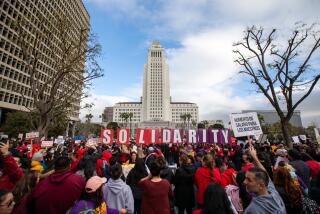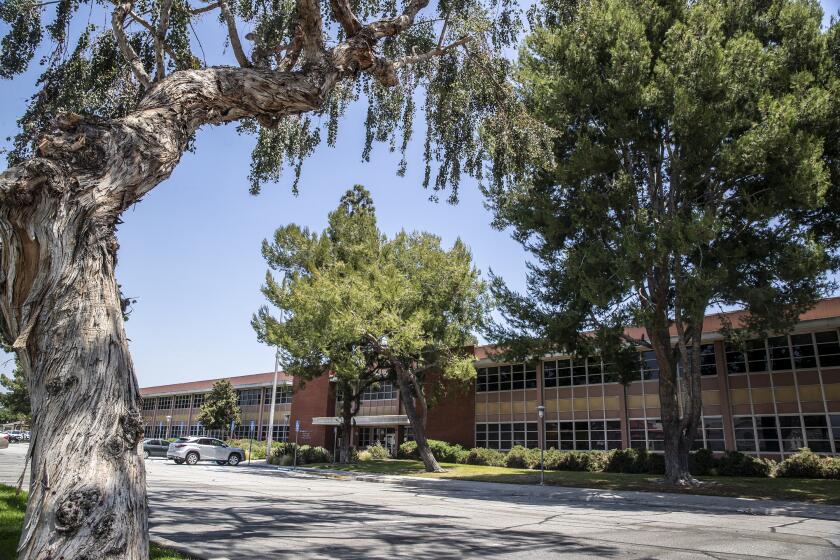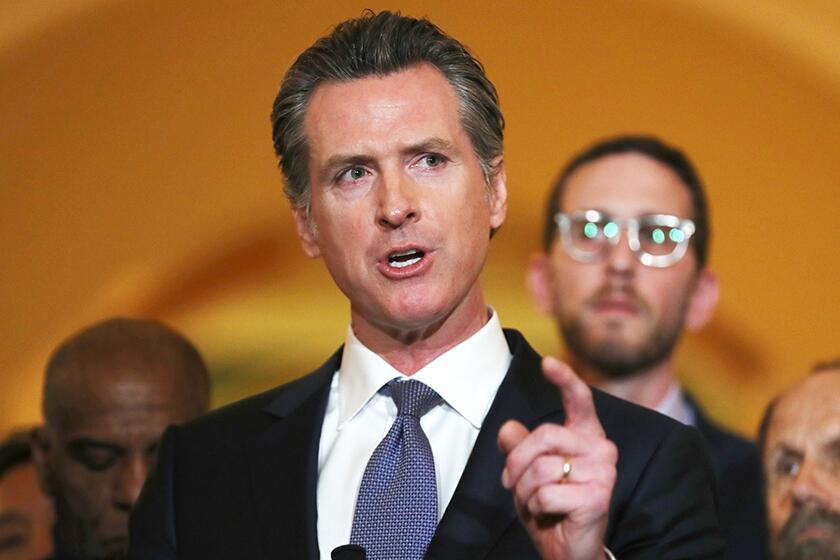Column: As teachers’ strike looms, L.A. schools aren’t failing us. We’re failing them
- Share via
On the eve of a massively disruptive strike that would hit families at more than 900 schools, Los Angeles Unified teachers say they deserve a better deal on pay and working conditions.
The district has given some ground in recent days but argues that on at least the money issues, budget projections are grim despite a current reserve, and you can’t give away what you don’t have.
So who’s in the right?
Both sides, to a point.
After spending two months at a Pacoima elementary school late last year, I was more convinced than ever that public schools aren’t failing us, we’re failing them. We spend a fortune on education, but 80% of L.A. Unified’s several hundred thousand students live in poverty, and schools don’t have enough resources to compensate for a skewed economy and societal challenges beyond their control.
Demanding a bigger state investment in children appeals to both teachers and administrators who know that in years past, California was in the top ranks nationally in spending per pupil. But even if schools got more money per student, it might not be enough to cover repairs for long-neglected facilities, to reopen libraries and rehire counselors and social workers and nurses, and to rein in the projected ballooning of multibillion-dollar healthcare costs for LAUSD employees and retirees.
So what can be done about all that? And does the arrival of a new governor interested in both healthcare reform and child welfare offer room for optimism, especially given the current state budget surplus?
In L.A. Unified, teachers make in the $50,000-to-$80,000 range, depending on training and experience. It’s not the highest or the lowest teacher compensation in the land, but local housing costs burn a big chunk of every paycheck. A relatively generous benefits package helps sweeten the deal for teachers and other LAUSD employees, but that’s also one place where the district’s bills keep piling up, despite an agreement last year to temporarily freeze costs.
As my colleagues Howard Blume and Sonali Kohli reported last February:
“The district pays more than $20,000 annually for the healthcare of each retiree who is too young to qualify for the federal Medicare program…. Older retirees use district benefits as a healthcare supplement to cover what Medicare doesn’t, which costs the district about $7,100 per person each year.
“As of January, the district was providing benefits for 4,768 pre-Medicare retirees and paying for supplemental coverage for 31,533 retirees old enough to receive Medicare. Retiree health benefits cost the district nearly $328 million in the 2016-17 school year, close to 6% of the budget.”
The district projected at the time that it would cost $13.6 billion over the next 30 years to cover all retiree health benefits, but only a fraction of that money has been set aside.
So whatever happens in coming days regarding the stalemate, the nation’s second-largest school district is probably headed for big trouble in the years ahead.
There are some answers, but consensus is elusive.
LAUSD teachers get lifetime healthcare benefits not just for themselves, but also for spouses, and the deal comes with fees but no premiums.
In a perfect world, that would be the norm for all of us rather than the exception. But we are not living in such a place, and it appears that Donald Trump’s promise of cheaper and better healthcare for all is on the same schedule as his national infrastructure rebuilding program.
Some argue that a tidy sum could be saved if in the future, LAUSD spouses were on their own to supplement Medicare. That could help pay for teacher raises and smaller class sizes, but that’s not a chip the teachers union wants to surrender. And the revenue benefits would take years to accumulate if a change applied only to new employees.
Is there a way to establish a single-payer system for all the state’s teachers and retirees, with the goal of lowering the total payout and private profiteering while easing the budget crunch on school districts?
That would be tough, said L.A. County Supervisor Sheila Kuehl, who as a state legislator introduced statewide single-payer legislation that died. Targeting just teachers would make it difficult to come up with enough money and might impose an unfair financial burden on them.
“I definitely think California should engage in a discussion about single payer,” said Kuehl, arguing that a Medicare-type system would have much lower overhead costs than for-profit systems do.
But another single-payer attempt got run over in Sacramento last year amid concerns about how to pay for it. And although Gov. Gavin Newsom’s pitch Monday was for everyone in the state to be covered, including illegal immigrants, he wasn’t necessarily talking about replacing a private insurance system with one operated by the government.
David Crane, a public policy lecturer at Stanford University and former advisor to Gov. Arnold Schwarzenegger, suggested it’s not the healthcare system that matters, but how it’s managed and what we expect of it. Other developed countries have various systems, Crane said, but they also have something the U.S. doesn’t.
“They’re all successful because they have cost and utilization controls,” he said, or what were derisively referred to in the U.S. as death panels.
Among developed countries, we spend twice the average per person in the U.S. without necessarily getting better care. That’s partly because the powerful medical and insurance industries drive policy, and partly because we all want an MRI for a headache or a hangnail, all the way to our graves.
“There is a ton that governments can do to rein in these costs,” Crane said, such as reward hospitals that get better outcomes at lower rates, or clear the way for nurse practitioners and other staff to perform procedures now done exclusively and more expensively by doctors.
Crane said he just turned 65, signed up for Medicare, and pays about $400 a month for supplemental care. Rather than paying a blanket subsidy for supplemental Medicare plans for public employee retirees, he said, a small fortune could be saved by instead giving cash subsidies only to low-income retirees who can’t afford that extra protection.
Whether you buy or reject such ideas, they should be part of a broader conversation as California figures out where it’s headed under new leadership, and LAUSD figures out how to get through its current crisis.
I’m not sure what victory looks like right now, for either side, and I’m not sure they do either.
Let’s just hope that with each side arguing that they represent the kids’ best interests, they can figure out how to keep the doors open.
Get more of Steve Lopez’s work and follow him on Twitter @LATstevelopez
More to Read
Sign up for Essential California
The most important California stories and recommendations in your inbox every morning.
You may occasionally receive promotional content from the Los Angeles Times.











